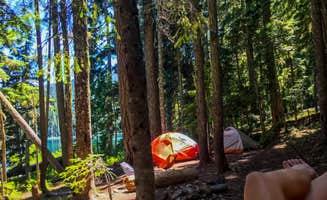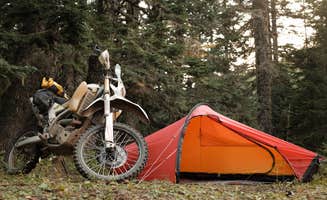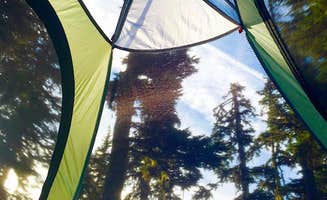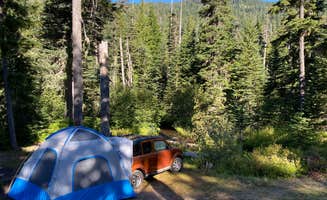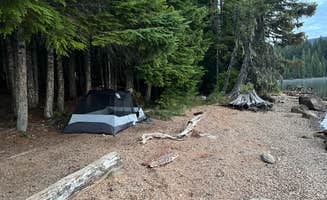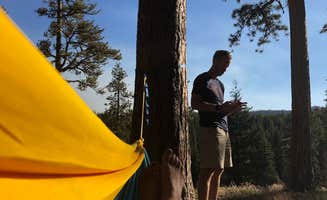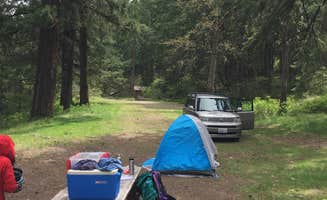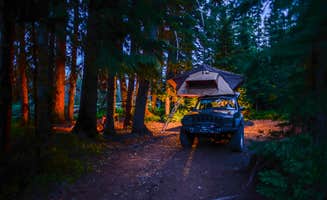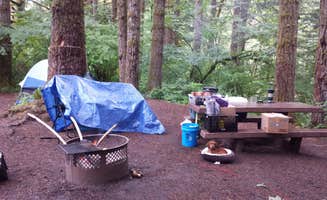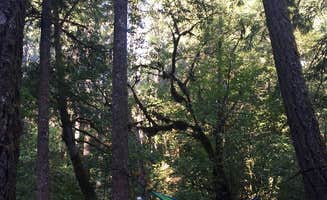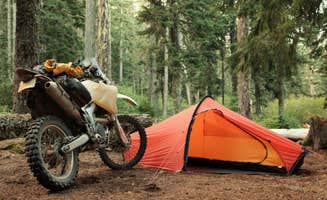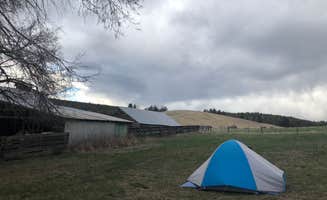Tent camping options near Government Camp, Oregon provide varied experiences across Mount Hood National Forest from 2,800 to 6,000 feet elevation. Winter snowfall can exceed 300 inches annually, making most primitive camping areas accessible only from late June through early October. Most Forest Service roads to dispersed sites require higher clearance vehicles due to rough, potholed surfaces.
What to do
Hiking to alpine lakes: At Burnt Lake, the 4-mile trail leads to secluded camping with mountain views. "If you put down your stuff at your site, you can do another 2 mile hike up the summit of East Zigzag Mt. and see a beautiful view of Mt. Hood," notes camper Sonja O.
Kayaking and paddleboarding: Meditation Point Campground offers direct water access for small watercraft. "We took our inflatable kayak. Trail was well maintained as well as the campsites," reports Jesse H., who stayed at site 7 which has "a beachy area for playing in the water or launching water craft."
Fishing for trout: The lakes around Mount Hood are stocked with fish during summer months. "The lake is gorgeous and saw people catching trout. Bring a kayak or SUP to enjoy the lake," advises Lisa K. about Badger Lake Campground.
Star gazing: Higher elevation campsites provide exceptional night skies due to limited light pollution. "The stars up there are incredible, and there are lots of great hiking trails nearby," reports Bridget H. about Cloud Cap Saddle's remote location.
What campers like
Seclusion from crowds: The more difficult access roads often lead to quieter camping areas. "The road leading into the campgrounds is primitive and just challenging enough to keep most folks away," writes Chris H. about Kinzel Lake Campground. "I've never seen another person down here."
Lake proximity: Campsites directly on lake shores are highly sought after. "Great spot! Super easy to drive in, with lots of options for spots. We parked at the top of the hill and walked about 5 min down to our spot right on the creek," reports Jordan C. about Barlow Crossing.
Temperature relief: Higher elevation camping offers cooler summer temperatures compared to Portland or the Columbia River Gorge. "It is very beautiful but when they say it's a rough road it is a very very rough and rocky road. I barely made it in my four-wheel drive," warns Jason P. about the road to Badger Lake Campground.
Winter camping options: "If you are looking for winter camping in the summer, Mt. Hood is the place to go. Obtain a self permit from the visitor's center at the base of the mountain and you can camp anywhere above the ski lift," suggests Shannon C.
What you should know
Access challenges: Most dispersed camping areas require high-clearance vehicles. "You'll want a high clearance/4wd vehicle. We took my Honda Element and had to camp in the campground instead of near the lake, which was 1/4 mile from campground. Too many big rocks and ruts in the road to attempt," warns Lisa K.
Permit requirements: Wilderness areas require permits during peak season. "We were able to get a spot midweek. Beautiful spot on the end of the peninsula. Easy 1.5 mile hike in," notes Kerri K. about camping at Meditation Point.
Water sources: Most backcountry sites lack potable water. "No water available when we were there. There is one pit toilet. Was perfect for an impromptu night of camping!" reports Justine B. about Alpine Campground.
Weather preparation: Even summer nights can drop below 40°F at higher elevations. "We went in May, so there was still snow, and the lake was so full it had flooded part of the trail, making the backside campsites inaccessible," shares trena E. about conditions at Burnt Lake.
Tips for camping with families
Beginner backpacking options: Choose shorter trails for first family backpacking experiences. "4 in our group, two of us were first time backpackers. This was a great intro to backpacking," writes trena E. about Burnt Lake.
Safer swimming areas: Several lakes have gradual entry points ideal for children. "We fished, grilled up our fresh fish and swam until we were all cooked," shares Sarah W. about Meditation Point, but warns "there were a ton of bees. Mostly hidden in the ground, so just be super care... I think my sister and I each got 5 stings."
Wildlife viewing opportunities: Dawn hours offer the best chance to spot deer near campsites. "We always have deer come visit us," reports Kelly K. about her favorite dispersed site at Barlow Crossing.
Road condition preparation: "Don't let the Trillium Lake camp hosts scare you. They told us the gravel road to access the sites was 'rough as hell' and were completely wrong. Nothing more than a few potholes. Any vehicle could make the trek," advises Kenny L. about NF2656 - Mt. Hood Dispersed Camping.
Tips from RVers
Small trailer considerations: Only certain campgrounds accommodate trailers over 18 feet. "The campsite was clean and relatively level. However bring an extra block for your tongue jack," advises ron R. about camping at 39 Rd Dispersed Site.
Cell service availability: "The only reason it wasn't five stars is because there's absolutely no T-Mobile cellular internet service. There is cell phone operation," notes ron R. about camping near Barlow Trail, while another camper reported "Nice quiet no frills spot. Great cell service which is a plus" at the same area.
Generator regulations: Most campgrounds prohibit generator use during quiet hours (10pm-6am). "We arrived around 4 pm the Sunday of Labor Day and grabbed the last site. The first few sites when you enter are pretty private which is nice, sites further down the road more open," reports Justine B. about Alpine Campground.


